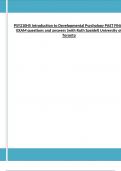Exam (elaborations)
PSY210H5 Introduction to Developmental Psychology PAST FINAL EXAM questions and answers (with Ruth Speidel) University of Toronto
- Course
- Institution
PSY210H5 Introduction to Developmental Psychology PAST FINAL EXAM questions and answers (with Ruth Speidel) University of Toronto
[Show more]



